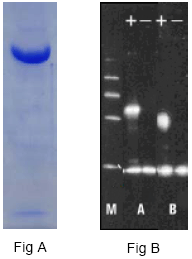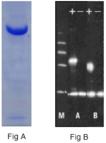Ubiquitin activating enzyme E1 is responsible for the first step in ubiquitin-protein isopeptide bond formation and is a critical component for the initiation of in vitro conjugation reactions. E1 activates ubiquitin by first adenylating with ATP the C-terminal glycine carboxyl group of ubiquitin and, thereafter, linking this residue to the sulphydryl side chain moiety of a cysteine residue in E1 by forming a high energy thiol ester bond and liberating free AMP. There are two active sites within the E1 molecule allowing it to accommodate two ubiquitin molecules at one time, with a new ubiquitin forming an adenylate intermediate as the previous one is transferred to the thiol site. The activated ubiquitin is then transferred to the lysine of target proteins via the E2/E3 conjugation cascade.
Product Details
| MW: | 118 kDa |
| |
| Source: | Produced in E. coli BL21 (λDE3) expression system and containing a C-terminal His6-tag. Full length human ubiquitin-activating enzyme E1. |
| |
| UniProt ID: | P22314 |
| |
| Formulation: | Liquid. In 50mM TRIS-HCl, pH 7.5, containing 1.0mM DTT. |
| |
| Purity: | ≥90% (SDS-PAGE) |
| |
| Purity Detail: | Purified by multi-step chromatography. |
| |
| Shipping: | Dry Ice |
| |
| Long Term Storage: | -80°C |
| |
| Handling: | Avoid freeze/thaw cycles. |
| |
| Scientific Background: | Results demonstrate the formation of ubiquitin thioester linked E2 conjugates of the expected size in all TE +ve control reactions. The absence of such conjugates in TE –ve control reactions demonstrates that their formation is ATP dependent (required for E1 activation) and hence derived from the ubiquitin cascade. |
| |
| Regulatory Status: | RUO - Research Use Only |
| |

Figure A: Product purity determined by Coomassie staining following SDS-PAGE
Figure B: Western Blot of thioester assays (TE +ve/-ve controls) for E2 conjugating enzymes. Biotinylated-ubiquitin-enzyme conjugates were detected by western blotting on thioester assays containing: A: UbcH2 (Prod. No. BML-KW9025), B: UbcH8 (KW9135), respectively, using Streptavidin-HRP detection system. M: Biotinylated SDS molecular weight markers (Sigma, SDS-6B) from bottom: 20.1, 29.0, 39.8, 58.1kDa.
Please mouse over
Product Literature References
Structural basis for HIV-1 antagonism of host
APOBEC3G via Cullin E3 ligase: F. Ito, et al.; Sci. Adv.
9, eade3168 (2023),
Abstract;
Protocol to detect in vitro and in cell ubiquitylation of mitochondrial DNA polymerase gamma by mitochondrial E3 ligase MITOL: M. Hussein, et al.; STAR Protoc.
3, 101710 (2022),
Abstract;
Redox-sensitive E2 Rad6 controls cellular response to oxidative stress via K63-linked ubiquitination of ribosomes: V. Simões, et al.; Cell Rep.
39, 110860 (2022),
Abstract;
TDP-43 is a ubiquitylation substrate of the SCFcyclin F complex: S.L. Rayner, et al.; Neurobiol. Dis.
167, 105673 (2022),
Abstract;
CD95/Fas suppresses NF-kB activation through recruitment of KPC2 in a CD95L/FasL-independent mechanism: J.P. Guégan, et al.; iScience
24, 103538 (2021),
Abstract;
The cooperative action of CSB, CSA, and UVSSA target TFIIH to DNA damage-stalled RNA polymerase II: Y. Weegen, et al.; Nat. Commun.
11, 2104 (2020),
Abstract;
Full Text
ILF3 is a substrate of SPOP for regulating serine biosynthesis in colorectal cancer: K. Li, et al.; Cell Res.
30, 163 (2019),
Abstract;
Full Text
Biophysical and biological evaluation of optimized stapled peptide inhibitors of the linear ubiquitin chain assembly complex (LUBAC): F. Aguilar-Alonso, et al.; Bioorg. Med. Chem.
26, 1179 (2018),
Abstract;
BLM Potentiates c-Jun Degradation and Alters Its Function as an Oncogenic Transcription Factor: R. Priyadarshini, et al.; Cell Rep.
24, 947 (2018),
Abstract;
Role of ubiquitylation of components of mitotic checkpoint complex in their dissociation from anaphase-promoting complex/cyclosome: D. Sitry-Shevah, et al.; PNAS
115, 1777 (2018),
Abstract;
Full Text
Modulating cellular balance of Rps3 mono-ubiquitination by both Hel2 E3 ligase and Ubp3 deubiquitinase regulates protein quality control: Y. Jung, et al.; Exp. Mol. Med.
49, e390 (2017),
Abstract;
Full Text
The Ubiquitin Ligase CHIP Integrates Proteostasis and Aging by Regulation of Insulin Receptor Turnover: R. Tawo, et al.; Cell
169, 470 (2017),
Abstract;
Full Text
Monoubiquitination Inhibits the Actin Bundling Activity of Fascin: S. Lin, et al.; J. Biol. Chem.
291, 27323 (2016),
Abstract;
Full Text
Regulation of the Abundance of Kaposi's Sarcoma-Associated Herpesvirus ORF50 Protein by Oncoprotein MDM2: T.H. Chang, et al.; PLoS Pathog.
12, e1005918 (2016),
Abstract;
Full Text
F-box protein Fbxl18 mediates polyubiquitylation and proteasomal degradation of the pro-apoptotic SCF subunit Fbxl7: Y. Liu, et al.; Cell Death Dis.
6, e1630 (2015),
Application(s): Assay,
Abstract;
Full Text
Pro-apoptotic F-box protein Fbxl7 regulates mitochondrial function by mediating the ubiquitylation and proteasomal degradation of survivin: Y. Liu, et al.; J. Biol. Chem.
290, 11843 (2015),
Application(s): Assay,
Abstract;
Full Text
UBXN2A regulates nicotinic receptor degradation by modulating the E3 ligase activity of CHIP: Y. Teng, et al.; Biochem. Pharmacol.
97, 518 (2015),
Application(s): Western Blot,
Abstract;
ZNRF1 promotes Wallerian degeneration by degrading AKT to induce GSK3B-dependent CRMP2 phosphorylation: S. Wakatsuki, et al.; Nat. Cell Biol.
13, 1415 (2011),
Abstract;
Ubiquitin-activating enzyme. Mechanism and role in protein-ubiquitin conjugation: A. L. Haas, et al.; J. Biol. Chem.
257, 2543 (1982),
Abstract;
Activation of the heat-stable polypeptide of the ATP-dependent proteolytic system: A. L. Cienchanover; PNAS
78, 761 (1981),
Abstract;













